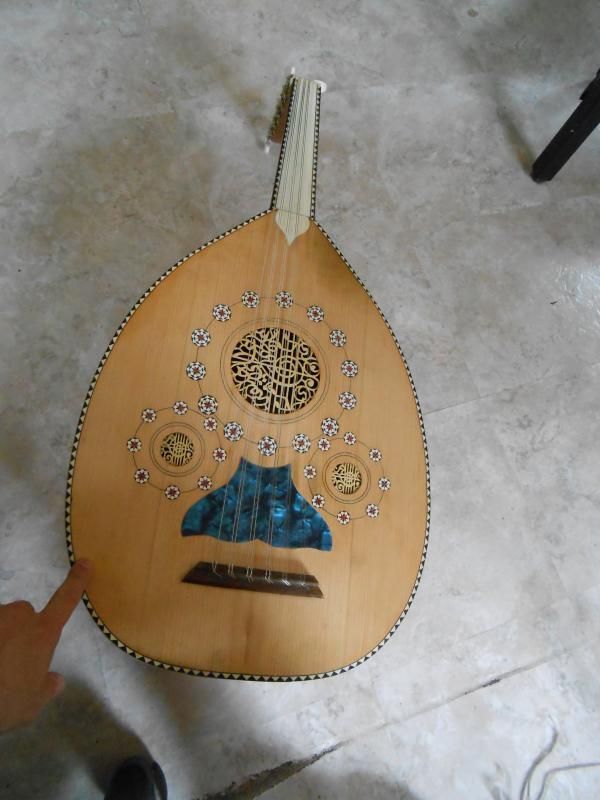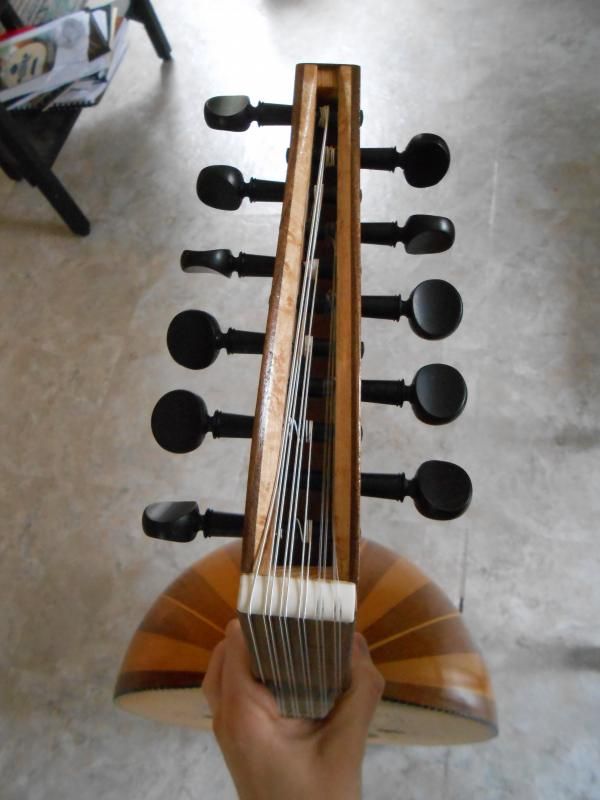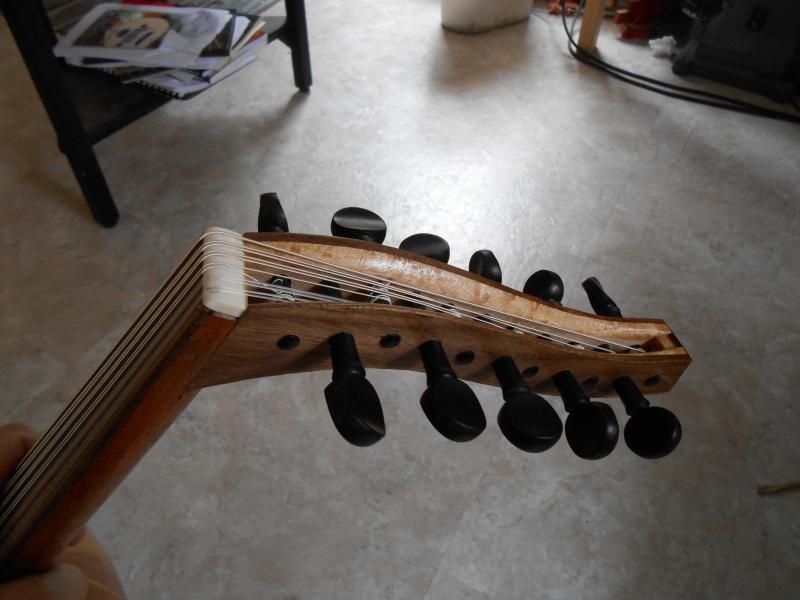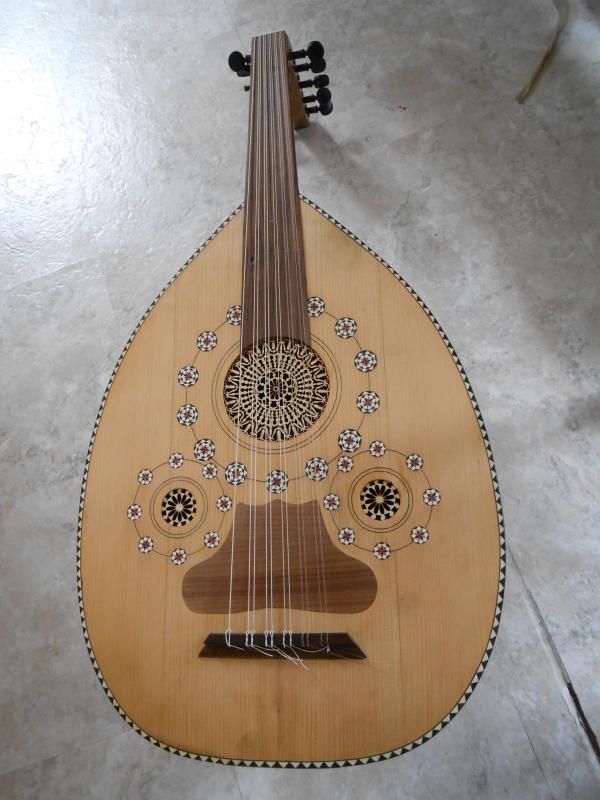
Boud - 11-9-2014 at 07:33 AM
Hi, I just got a Kamil Mowais Oud. This is my first Oud, but I am play multiple other stringed instruments and am an amateur luthier.
The guy I got it from said that he got it from the oudman in NYC who repaired it (http://www.oudman.com/). It has seen several repairs. The sound board has repaired cracks along the grain and the sound board around the bridge
is sunk in a bit.
The only issue now is that these is a good sized crack along one side of the pegbox - but this should be a relatively simple repair. Overall it is in
pretty good shape and sounds pretty good.
From these other posts I am guessing that it is probably from the early 1980s?
http://www.mikeouds.com/messageboard/viewthread.php?tid=12901
http://www.mikeouds.com/messageboard/viewthread.php?tid=10917
Do anyone have an idea on its age from the pictures?
Also it appears as though it once had rosettes as I can fell the leftover glue just inside the sound holes. I have access to a laser cutter and was
thinking about making some new rosettes. On this board they are varying opinions on how they effect the sound and whether it sounds better if you
remove them. Any opinions on adding new ones?
Also does anyone have an idea on the value of this instrument in its current state?
[file]33202[/file] [file]33201[/file] [file]33200[/file]
[file]33205[/file] [file]33204[/file] [file]33203[/file]
bulerias1981 - 11-9-2014 at 12:41 PM
Hello Boud,
This looks like a nice instrument made by a respectable luthier in Palestine.
Regarding the crack on the side of the pegbox, I'm sad to say that this is not such a simple repair, and if it's not done right, tuning will be a
problem. Usually I end up making a new pegbox with walls made of two different woods so that splitting like this never occurs.
It is possible for a competent luthier to get some glue in the crack and clamp it, but this is not a good long term fix as it will likely spring back
open.
Where do you live?
Thanks,
John Vergara
Boud - 11-9-2014 at 07:05 PM
John,
I am near baltimore.
Yes, perhaps not such an easy fix... I need to take out all of the pegs tomorrow and see if the crack naturally closes up and do a little more
research on my options.
I have seen a few interesting violin peg box repairs:
http://www.florianleonhard.com/fileadmin/docs/Conical_Bushings_Fina...
http://www.pasewicz.com/reinforcing-cracked-pegbox-wall/
bulerias1981 - 11-9-2014 at 07:49 PM
Yeah, I do these kind of repairs on violins. They are very expensive, and we only do this kind of repair for one hole, the A peg hole on the violin,
because it's prone to split there being it is the narrowest point on the pegbox. With the oud, especially yours, I'd have to bind 7 or 8 holes on BOTH
sides. It's easier and cheaper to just make a new pegbox.
The luthiers in the links you provided learned this method of repair from my teacher whom I apprenticed with, Joe Regh. https://www.youtube.com/watch?v=OEGeWUidpaw
At any rate the crack won't close up naturally and at the end of the day you need pegs in there, which when you push them in, they want to split the
pegbox more.
If you need any assitance, please let me know via e-mail.
Thanks!
journeyman - 11-9-2014 at 09:17 PM
Nice oud; congratulations. John, is it possible that such a crack occurs from swelling due to humidity during a period when the pegs are not turned
rather than normal use? If so, wouldn't glue and clamps solve the problem? -Roy
Doc139 - 11-9-2014 at 10:06 PM
I have a Kamil Mowais oud myself and I am very happy with it over all. But I am facing actually the same problem of a (in my case just beginning)
crack at one side of the pegbox between two peg holes, due to the very thin wall of the pegbox made only from one sort of wood (instead of two, as
John/bulerias1981 explaines further above). I am therefore thinking of getting made a completely new pegbox as suggested.
Alexander
bulerias1981 - 11-9-2014 at 10:06 PM
Glue and clamps won't solve the problem long term, (or at all) because of the grain orientation.. if the pegbox walls are made from one kind of wood
only, it's vulnerable to break along those grain lines. I've seen some shabby repairs with studs glued inside the pegbox, but that also just buys you
time.
I think this break happens mostly during shifts in humidity. When the humidity is low, the pegs are driven further into the holes, if the humidity
shifts quickly, this could easily split apart the grain.. which is the weakest part of the wood. Actually the pegs also become enlarged during high
humidity and that can push the pegbox apart as well. Every piece of wood is different of course, different density, grain/cell structure.
This problem could also be due to poorly fitted pegs, which is a common problem with ouds unfortunately. Forcing the peg hard into the pegbox in an
attempt to get it to "stay" without slipping, could help split the pegbox. Also, pegs that are too tight tend to stick too much, could also contribute
to this issue.
Here's a photo of a pegbox I made that shows two different woods being used in forming the pegbox wall. In this case, walnut on the outside and maple
on the inside. Many makers do it, I believe most or all Turkish makers do this. It's very smart and certainly more future proof.

Alfaraby - 11-10-2014 at 02:31 PM
Welcome aboard 
Congratulations Boud. Good choice.
Age: Telling from the photos, I think you're right. It's from the late 1980's.
Rosettes ? Yes, I think you should consider putting a new set. It's available at the workshop. Just drop them a line via their
e-mail.
Value ? It depends on the general condition and the sound. The more it is healthy and has the typical "Arabian" sound, the more its
value would jump. I'd dare and evaluate this oud for somewhere between 1.5-2.5k$.
Pegpox: I tend to believe that any replaced part of an oud will for sure effect its whole structure and eventually its value. Never
replace it even if "this is not such a simple repair" as John said. BTW, I do think it's as simple as described. Very good super glue gel, seeped down
the crack, held over night in tight clamps would make the two cracked parts into one. However I'd advise to replace the pegs with a precise cone of
1:30 set of rosewood pegs, conditioned you have in hand a matching reamer of 1:30 to ream the healing pegbox with.
On the other hand, it's very recommended to consider geared planetary finetune pegs. The cheapest are available from Knilling for
210$. Pretty expensive but worth every penny. You may read more about finetune pegs here: http://www.mikeouds.com/messageboard/viewthread.php?tid=13127#pid95...
Therefore start driving to John's workshop in Beacon, NY. He's only 250 miles away.
I wish I could 
Good luck and please keep this oud for your grandchildren
Yours indeed
Alfaraby
bulerias1981 - 11-10-2014 at 05:01 PM
I wouldn't advise anyone to super glue anything, I've seen more instruments ruined when adhesives were used like this. I have all the adhesives under
the sun. I've done what you've suggested once for someone who was on a budget, only for the pegbox to break not long later in a different spot. I
ended up doing a new pegbox after that. Nothing like a pegbox with two different woods/grain structures. Fine tune pegs are expensive and so is the
labor to install them. Either way, pegbox crack is a problem and expensive to repair.
I also want to argue against the idea that changing parts (especially wear and tear parts) lowers the value. Look at Simon Shaheen's Nahat. You will
tell me because the soundboard, pegs, fingerboard is new that it's not incredibly valuable? In a case like this, if a new quality pegbox can be made
of two different woods, identical size, well fitted pegs, surely this adds to the instrument, not diminishes.
Come on Alfaraby, you can drive here too!! or maybe take a boat!! You'll be well received here in oud heaven!! 
Attached are some photos of a Khalife oud. I did a lot of "invasive" work to this instrument, including removing the white plastic fingerboard (meant
to look like bone), removed the cracked pegbox with a new one made of maple and walnut, installed finetune pegs! (a request from the customer),
removed the tacky plastic rosettes with elegant rosettes cut from wood (re-designed by Alfaraby!) and removed the cheesy plastic pickguard with a
wooden one. If you played this oud the way it is now, you'd have no problem spending $2000 for a sound and feel like this, which is a fraction of what
these normally sell for. So this is why I don't believe in the idea that changing parts out lowers the value of instruments.




Boud - 11-10-2014 at 06:16 PM
Thanks for all the constructive comments. I took out the pegs and the crack did not close - so it looks like tension in the pegbox is holding it
open.
I will probably try a less invasive method for repairing the crack a first. Perhaps by laminating the inside walls of the peg box in a manor similar
to the work that John has shown (very nice work BTW).
I have been looking for an good excuse to use the laser cutter at my work and though that making some rosettes would be a good project. What is the
typically thicknesses of the rosettes and what types woods are typically used?
bulerias1981 - 11-10-2014 at 06:51 PM
Laser cutters are great for cutting rosettes. You can use a 4mm 5x birch plywood. You can use 3x ply, but I prefer the 5x mirco plys
ameer - 11-10-2014 at 07:58 PM
Hello Boud. I was discussing the cracks in your pegbox with Najib Shaheen and he recommends the following for a quick fix:
1. Remove all the pegs but mark them in such a way as to show where they belong.
2. Insert one peg into the hole where the crack is. Tilt the peg so that the crack widens slightly.
3. Fill the crack with yellow glue.
4. Clamp the hole shut. Put a piece of wood on top and underneath the pegbox to avoid damaging it. Leave it overnight.
5. Sand the area of the pegbox where the crack is from the inside to remove any oil deposits or polish.
6. Take a piece of wood, preferably walnut, measuring 2 mm thick by 5 mm wide by 8 mm long. Clampp it to the inside of the pegbox where the crack is.
Make sure that the grain is perpendicular to the grain of the pegbox wall.
7. Optionally shave and finish the new piece of wood to make it fit in with the rest of the pegbox.
SamirCanada - 11-11-2014 at 02:10 AM
I am with john here, gotta make a new pegbox, just use similar looking walnut and it won't look out of place. Use the old peg box for a template to
make it identical.
I also make the pegbox with maple lined walls, this crack with solid walnut pegbox is very common.
Although no one mentioned it, something may be going on with the first brace in front of the bridge, that's a lot of dip for a Oud. Since there is no
rosette check to see if the braces are glued to the side of the Oud. then again it may be fine that way, there are a few ouds designed to have that
dip but it's not the norm.
Alfaraby - 11-11-2014 at 11:11 AM
John dear ! We don't have to agree upon everything.
I'd swim the ocean one day just to meet you. Don't loose hope 
I made this repair myself (all thumbs in general) two years ago to an ebony pegbox and it's still there, working perfectly.
What you have done to Khalifah's oud is upgrading it from a commercial oud up to a proffessional standard.
On the other hand, if the same repairs were made to a 100 years Nahhat, that would undoubtly effect its value, not to mention its whole structure.
I think that the problem lies in the pegs rather than in the house. Softwood pegs tend to shrink and make a ring that harms the cone. Pushing the peg
inside the hole to compensate that ring causes harm to the box.
Good hardwood pegs, softwood interior of the pegbox, exact cone of both the pegs & the reamer will ensure this would never happen again.
Good luck to you all
Yours indeed
Alfaraby









